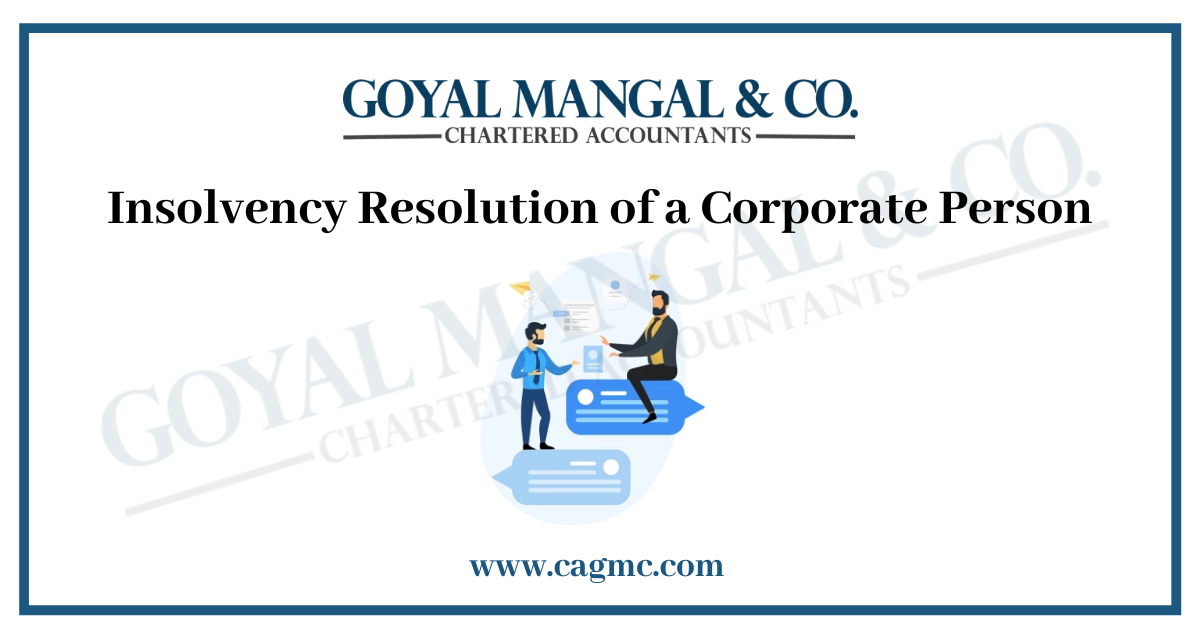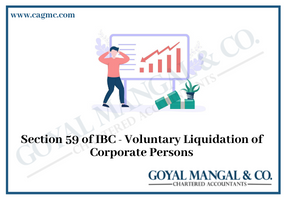
If you have investments in a business and are afraid of losing the investment then you should know about the Insolvency Resolution. The Insolvency and Bankruptcy Code (IBC), 2016 provides a time-bound process to resolve insolvency. The Code outlines separate insolvency resolution processes for individuals, companies and partnership firms. The code aims to protect the interests of small investors and make the process of doing business less cumbersome. The IBC process may be initiated by either the debtor or the creditors. In this article, we will discuss, the Insolvency Resolution of a Corporate Person.
| Table of Content |
Meaning of Debt and Default
The words ‘debt’ and ‘default’ are used in many places in the IBC. Thus, it is very important to know about them.
As per Section 3(12) of the IBC, ‘Default’ means non-payment of debt when whole or any part of instalment of the amount of debt has become due and payable and is not paid by the debtor.
Further, as per section 3(11) of IBC, “Debt” means the liability or obligation in respect of a claim which is due from any person. Moreover, it includes financial debt and operational debt.
Financial Debt
“Financial debt” means a debt along with interest, if any, which is disbursed against the consideration for the time value of money. Further, it may include,
- Money borrowed against the payment of interest.
- Any amount raised by acceptance under any acceptance credit facility or its de-materialised equivalent.
- Any amount raised pursuant to any note purchase facility or the issue of bonds, notes, debentures, loan stock or any similar instrument.
- The amount of any liability in respect of any lease or hire purchase contract which is deemed as a finance or capital lease under the Indian Accounting Standards or such other accounting standards as may be prescribed.
- Receivables sold or discounted other than any receivables sold on a non-recourse basis.
- Any amount raised under any other transaction, including any forward sale or purchase agreement, which has the commercial effect of a borrowing.
Meaning of Insolvency and Bankruptcy
Insolvency means the short-term inability to meet the liabilities during the normal course of business. However, it can be resolved by changing the re-payment plan of the loan. However, if it cannot be resolved then legal action may be taken.
Bankruptcy is slightly different from insolvency. Bankruptcy means a long-term inability to meet the liabilities. Further, the person himself voluntarily declares themselves insolvent and approaches the court
Applicability of IBC
The IBC is applicable to,
- A company incorporated under the Companies Act, 2013 or any other previous law.
- Any other companies governed by any Special Act.
- Any other body corporate incorporated under any law for the time being force, as notified by the CG.
- Limited liability partnership (LLP) incorporated under Limited liability partnership 2008.
- Personal Guarantors to Corporate Debtors.
- Partnership Firms and Proprietorship Firms.
- Individuals.
Who can initiate the Insolvency Resolution process?
Where any corporate debtor commits a default, the Corporate Insolvency Resolution Process (CIRP) can be initiated by,
- Financial Creditor (Section 7)
Any person to whom a financial debt is owed and includes a person to whom such debt has been legally assigned or transferred. - Operational Creditor (Section 8 & 9)
Any person to whom an operational debt is owed and includes any person to whom such debt has been legally assigned or transferred. - Corporate Applicant (Section- 10)
Corporate applicants include,
(a)Corporate Debtor (CD)
(b)Member or partner of the Corporate Debtor
(c)Individual in charge of managing CD
(d)Person who has control over CD
Section 7 (Financial Creditor)
A Financial Creditor can make an application either by itself or jointly with other financial creditors to the National Company Law Tribunal (NCLT) for initiating the CIRP.
The Financial Creditor needs to provide certain information along with the application. These pieces of information are,
- Record of the default recorded with information utility or any other record or evidence of default
- Name of the proposed resolution professional to act as an interim resolution professional
- Any other information as may be specified by the Board.
The NCLT either accepts or rejects the application filed by a financial creditor, within 14 days of receiving the application.
If the NCLT is satisfied that there is an existence of default and the application is complete and no disciplinary proceedings are pending against the proposed resolution professional, it admits the application. However, if it finds that the default has not occurred or the application is incomplete or any disciplinary proceeding is pending against the proposed resolution professional, it may reject the application. Moreover, a notice shall be given to rectify a defect in the application within 7 days from the receipt of the application. The NCLT communicates, within 7 days of admission or rejection of such application,
- to the financial creditor when the application is accepted
- to the financial creditor where the application is rejected
Section 8&9 (Operational Creditor)
The process of insolvency resolution can be initiated by an operational creditor, by delivering a demand notice or a copy of an invoice demanding payment of the amount involved in the default to the corporate debtor.
As per, section 8(1) of the IBC, the operational creditor is required to deliver a demand notice of unpaid operational debtor copy of the invoice to the Corporate Debtor.
Further, The operational creditor has to send a demand notice in form 3 or a copy of the invoice in form 4 as contained in Insolvency and Bankruptcy (Application to Adjudicating Authority) Rules, 2016.
As per section 8(2)(a) of the IBC, the corporate debtor is required to reply within ten days of receipt of a copy of the invoice, existence of a dispute, or record of the pendency of the suit or arbitration proceedings filed before the receipt of such notice or invoice in relation to such dispute.
Further, as per – section 9(1) of the IBC, if no reply is received within ten days from the date of delivery of the demand notice or copy of the invoice, the operational creditor may file an application before the NCLT to initiate a corporate insolvency resolution process.
The Operational Creditor has to provide certain other documents along with the application. These documents are,
- A copy of the invoice demanding payment or demand notice delivered by the operational creditor to the corporate debtor
- An affidavit to the effect that there is no notice given by the corporate debtor relating to a dispute of the unpaid operational debt
- A copy of the certificate from the financial institutions maintaining accounts of the operational creditor confirming that there is no payment of an unpaid operational debt by the corporate debtor, if available
- A copy of any record with information utility confirming that there is no payment of an unpaid operational debt by the corporate debtor, if available; and
- Any other proof confirming that there is no payment of an unpaid operational debt by the corporate debtor or such other information, as may be prescribed.
Further, an application fee of Rs. 2,000 has to be paid.
However, the application may be rejected if,
- It is incomplete
- Payment has been made to the operational creditor
- The creditor has not delivered the invoice or notice for payment to the Corporate Debtor
- A disciplinary proceeding is pending against the proposed resolution professional
Section 10 (Corporate Applicant)
A corporate applicant may file an application to the NCLT to initiate the resolution process. Further, it has provided certain documents along with the application, these documents are,
- Books of account and other documents
- Information about proposed interim resolution professional
- Copy of special resolution passed by the shareholders or resolution approved by 3/4th of the total corporate debt holders
A notice by the NCLT shall be given to rectify a defect in the application within 7 days from the receipt of application.
Further, if the NCLT is satisfied that the existence of the default and application is complete and no disciplinary proceedings are pending against the proposed resolution professional, it shall admit the application.
Conclusion
If the NCLT finds that there is enough proof given, it can initiate the CIRP. The Corporate Insolvency Resolution Process shall commence on the admission of the application. IBC provides protection to individuals, companies and partnership firms. It provides protection to businesses. The investors and creditors of a business can conduct their work without any fear of bad debt.


